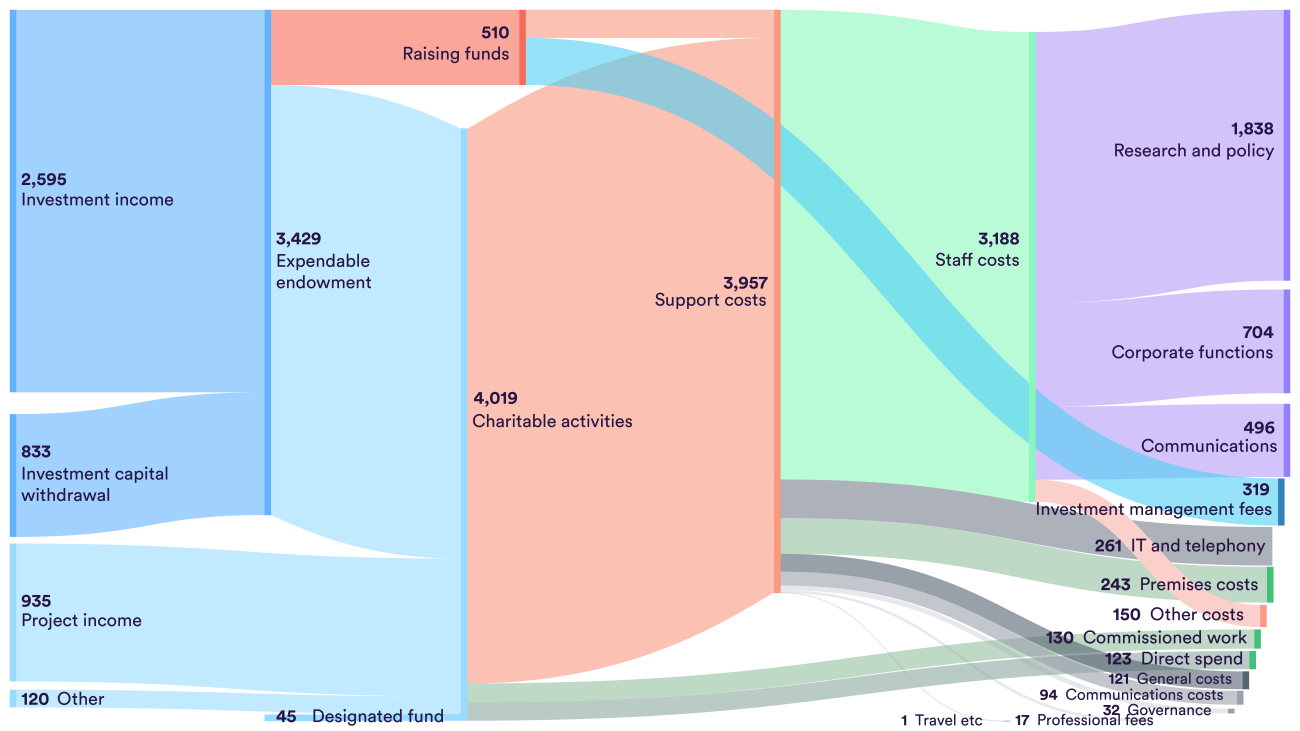How we are funded
Where the Nuffield Trust gets its money to fund projects and run the organisation, and how we spend that money. You can also read our latest annual reports to find out more about where our money has been spent recently.
The Nuffield Trust is a company limited by guarantee, registered in England and Wales as company number 382452. It is registered with the Charity Commission as charity number 209169.
We are funded primarily from income generated from the Nuffield Trust’s own endowment – this guarantees the independence of our research and wider activities. We are a not-for-profit organisation and not associated with any other organisations bearing the 'Nuffield' name (find out more here).
The endowment was given to the Nuffield Trust in 1940 by Viscount Nuffield. At the end of the 2021/22 financial year, the capital value of this endowment was about £88 million. We use our investment income to fund in-house research, support our infrastructure, and allow us to commission external research.
The Trustees have a total return strategy for the investment assets whereby income and capital returns are treated alike. Operational funds available for charitable activities are drawn down from the capital value of the portfolio at the rate of four per cent of the capital value of the investment assets averaged over a three year period. Hence in any one year, resources expended on charitable activities may exceed incoming resources.
This income generated from the endowment therefore continues to remain the most important source of income for the Trust, and ensures we are not dependent on any other source of income to carry out our charitable purpose (see chart below).
In addition, we undertake a small number of research projects funded by other research organisations and bodies – these are primarily in the public sector and include organisations such as the Department of Health and the National Institute for Health Research Service Delivery and Organisation programme.
We also generate sponsorship income from a range of public, private and voluntary sector organisations to support our events programme (particularly our annual Summit). These donations account for around five per cent of our income (see first chart above).
In deciding whether to accept funding for projects or sponsorship income, we consider whether the work is in accordance with our primary charitable purpose and whether it sits within our strategic work streams. Our ethical collaboration policy explores this in more detail.
As the chart below shows, we spend the majority of our income on our staff, infrastructure costs, and delivering our research and other projects.
Further information on financial matters and our governance structure is set out in our audited Report and Financial Statements.
More detail on where our money comes from and how we spend it
Charity accounting should help the readers of charity accounts to understand the flows of money, making it straightforward to identify sources of income and how money is being spent.
We try to make our accounts as accessible as possible, while still meeting the requirements of reporting standards. To this end, we’ve developed a visualisation of our 2021 accounts to help people understand the flows of money in more detail. We’ll keep working to make these more transparent in the future.
Key points
- Around 75% of our annual spend originates from our investment activities (our investments have ethical restrictions and we are continuing to develop our approach to responsible investing, using the UNSDGs, the Paris Climate accord and other influences to shape how we invest).
- The remaining 25% originates from projects, sponsorship for events or other similar sources. We receive grant funding originating from NIHR and other charitable grant makers, and we’re commissioned to complete projects by a range of organisations. The split of these is in the order of 50:50.
- We spent these funds on raising funds (11%), and on our charitable activities (89%).
- 67% of our total costs relate to payroll. Our staff are our greatest asset.
We hope to see more charitable organisations making their finances as transparent as possible in a similar way.
